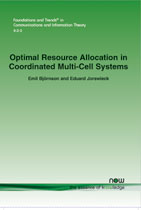Optimal Resource Allocation in Coordinated Multi-Cell Systems
By Emil Björnson, KTH Royal Institute of Technology, ACCESS Linnaeus Center, Signal Processing Laboratory, KTH Royal Institute of Technology, Sweden and Alcatel-Lucent Chair on Flexible Radio, Supélec, Plateau du Moulon, France, emilbjo@kth.se | Eduard Jorswieck, Dresden University of Technology, Communications Theory, Communications Laboratory, Dresden University of Technology, Germany, eduard.jorswieck@tu-dresden.de
Abstract
The use of multiple antennas at base stations is a key component in the design of cellular communication systems that can meet high-capacity demands in the downlink. Under ideal conditions, the gain of employing multiple antennas is well-recognized: the data throughput increases linearly with the number of transmit antennas if the spatial dimension is utilized to serve many users in parallel. The practical performance of multi-cell systems is, however, limited by a variety of nonidealities, such as insufficient channel knowledge, high computational complexity, heterogeneous user conditions, limited backhaul capacity, transceiver impairments, and the constrained level of coordination between base stations.
This tutorial presents a general framework for modeling different multi-cell scenarios, including clustered joint transmission, coordinated beamforming, interference channels, cognitive radio, and spectrum sharing between operators. The framework enables joint analysis and insights that are both scenario independent and dependent.
The performance of multi-cell systems depends on the resource allocation; that is, how the time, power, frequency, and spatial resources are divided among users. A comprehensive characterization of resource allocation problem categories is provided, along with the signal processing algorithms that solve them. The inherent difficulties are revealed: (a) the overwhelming spatial degrees-of-freedom created by the multitude of transmit antennas; and (b) the fundamental tradeoff between maximizing aggregate system throughput and maintaining user fairness. The tutorial provides a pragmatic foundation for resource allocation where the system utility metric can be selected to achieve practical feasibility. The structure of optimal resource allocation is also derived, in terms of beamforming parameterizations and optimal operating points.
This tutorial provides a solid ground and understanding for optimization of practical multi-cell systems, including the impact of the nonidealities mentioned above. The Matlab code is available online for some of the examples and algorithms in this tutorial.
Optimal Resource Allocation in Coordinated Multi-Cell Systems
The use of multiple antennas at base stations is a key component in the design of cellular communication systems that can meet high capacity demands. The downlink transmission from base stations to users is particularly limiting, because many applications primarily create downlink traffic. The user devices should also be inexpensive and energy-efficient, thus only simple reception algorithms are feasible. Under ideal conditions, the gain of employing multiple antennas is well-recognized: the data throughput increases linearly with the number of transmit antennas if the spatial dimension is utilized to serve many users in parallel. The practical performance of multi-cell systems is however limited by a variety of non-idealities, such as insufficient channel knowledge, high computational complexity, heterogeneous user conditions, limited backhaul capacity, transceiver impairments, and the constrained level of coordination between base stations.
Optimal Resource Allocation in Coordinated Multi-Cell Systems presents in a tutorial manner a general framework for modeling different multi-cell scenarios, including clustered joint transmission, coordinated beamforming, interference channels, cognitive radio, and spectrum sharing between operators. The framework enables joint analysis and insights that are both scenario independent and dependent. A comprehensive characterization of resource allocation problem categories is also given, along with the corresponding numerical signal processing algorithms. This provides a pragmatic foundation for resource allocation where the system utility metric can be selected to achieve practical feasibility. The tutorial also derives and parameterizes the structure of the optimal resource allocation, in terms of beamforming vectors and optimal operating points. Optimal Resource Allocation in Coordinated Multi-Cell Systems provides a solid grounding and understanding for optimization of practical multi-cell systems and will be of interest to all researchers and engineers working on the practical design of such systems. The Matlab code is available online for some of the examples and algorithms in this tutorial.

Matlab Code Package | 0100000069_supp.zip (ZIP).
The Matlab Code Package zip file contains the following files:
- report.pdf: This is the documentation of the Matlab code supplement to the monograph "Optimal Resource Allocation in Coordinated Multi-Cell Systems" by Emil Björnson and Eduard Jorswieck
- codePackage.zip: The package contains Matlab implementations of many of the algorithms described in "Optimal Resource Allocation in Coordinated Multi-Cell Systems". The use of these algorithms is exemplified by Matlab scripts (m-files) that generate some of the figures shown in the monograph.